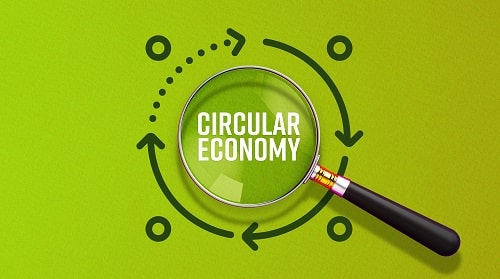Climate change is already affecting businesses around the world and will continue to hit bottom lines, disrupt supply chains, and impact workers’ health and wellbeing for decades to come – even if global efforts to reduce greenhouse gas emissions are successful. It is vital, therefore, that companies prioritise climate change adaptation measures alongside their mitigation strategies.
Features
Bracing for impact: businesses urged to prepare for effects of climate change
Record-breaking high temperatures and extreme weather-related events such as flooding, droughts and wildfires are dominating the headlines with increasing frequency. Last year was the hottest since records began. The average global temperature over the 12-month period between February 2023 and January 2024 was 1.52C above pre-industrial levels – breaching the 1.5C long-term limit set by world leaders under the 2015 Paris Agreement – data published earlier this year by the European Union’s Copernicus Climate Change Service showed.
 Photograph: iStock/mycola
Photograph: iStock/mycola
As the world continues to heat up and extreme weather events increase in frequency and intensity, businesses across all sectors are likely to feel the effects more and more – not only on their physical sites, supply chains and profit margins, but also on their workers. More than 70 per cent of the global workforce could be exposed to a “cocktail” of serious health hazards because of climate change, according to a report released in April by the International Labour Organization (ILO).
Exposure to excessive heat will affect more than 2.4 billion of the world’s 3.4 billion-strong workforce at some point, the United Nations body warns. Its report identifies five other climate-related threats facing workers: ultraviolet (UV) radiation; extreme weather events; workplace air pollution; vector-borne diseases; and changes in agrochemical use.
Speaking on a webinar hosted by the ILO and NEBOSH in April, Dr Andreas Flouris, an associate professor at the University of Thessaly in Greece and an expert on heat stress, described climate change as “the biggest threat to health and safety for at least the next 20 years”. Dr Halshka Graczyk, a technical specialist at the ILO, added that “workers and workplaces must be at the heart of climate action”.
 Exposure to excessive heat will affect 70 per cent of the world's workforce at some point. Photograph: International Labour Organization
Exposure to excessive heat will affect 70 per cent of the world's workforce at some point. Photograph: International Labour Organization
The World Economic Forum’s (WEF’s) Global Risks Report 2024, which is based on the findings of the Global Risks Perception Survey, highlights just how far up the risk agenda climate change is ranked. The latest report shows that two-thirds of the nearly 1,500 survey respondents rank extreme weather as the top risk most likely to present a material crisis on a global scale this year.
“It is also seen as the second-most severe risk over the two-year timeframe and, similar to last year’s rankings, nearly all environmental risks feature among the top 10 over the longer term,” says the WEF report.
Failing to prepare
Despite all the warnings, however, concerns have been raised about a lack of preparedness for the challenges that lie ahead.
Writing in Safety Management in June 2023, Baroness Brown, chair of the UK Climate Change Committee’s (CCC’s) Adaptation Committee, said that “while more businesses are now reporting their climate risks, disclosures on physical risk management and adaptation action are at an immature stage.” Baroness Brown added that, at best, businesses had made “limited progress” in developing climate change adaptation plans.
The UK Government has also come under fire for failing to prepare sufficiently for the effects of climate change. The UK is legally required under the Climate Change Act 2008 to adapt to climate change, and the government must produce a National Adaptation Programme (NAP) every five years to set out how it will address the risks. The latest programme, NAP3, was published in July 2023 and has been criticised by the CCC for falling “far short of what is needed”.
“NAP3 lacks the pace and ambition to address growing climate risks, which we are already experiencing in the UK,” says the CCC, adding: “The lack of a measurable vision will prevent effective delivery of adaptation by public agencies, local authorities and the private sector, as well as inhibiting a clear assessment of progress.”
The risks to UK workers were laid bare in a report published in February by the Environmental Audit Committee (EAC), which warned that heatwaves could claim thousands of lives a year in the UK and cause work-related injuries to spike. According to the report, the “silent killer” of heatwaves in the UK, without urgent action, could kill up to 10,000 people annually and severely impact workers’ physical and mental health, causing work-related injuries to increase and costing the economy £60 billion a year.
Taking action
There are signs that some companies are beginning to heed the warnings and prepare for the effects of climate change on their operations, however.
Network Rail, the publicly owned operator of Britain’s railway network, for instance, announced in April that it will invest £2.8 billion over the five years to 2029 in “activities and technology that will help it better cope with extreme weather and climate change.” The investment is part of a £45 billion plan which Network Rail says, “puts climate change firmly in its sights.”
 Network Rail is investing in improvements to drainage and embankments, to enable them to better handle intense rainfall. Photograph: Network Rail
Network Rail is investing in improvements to drainage and embankments, to enable them to better handle intense rainfall. Photograph: Network Rail
Meanwhile, Oxfordshire-based logistics, supply chain and manufacturing firm Unipart Group is in the process of carrying out a climate change adaptability study, the results of which it plans to publish later this year.
Network Rail will invest the bulk of the £2.8 billion in improvements to drainage and embankments, to enable them to better handle intense rainfall. This will include the recruitment of almost 400 extra drainage engineers. It will also train hundreds of operational staff at its new ‘weather academy’ to improve how they interpret weather forecasts and make decisions on where and when to limit the speed of trains.
Network Rail will invest in new technologies aimed at helping to keep services running in difficult weather conditions. Examples include GUSTO, which uses topography to predict wind speeds in different terrains so that trains can run at higher speeds during stormy weather, and real-time rainfall forecasting technology, which details weather conditions every 500 metres.
On announcing the investment package, Network Rail chief executive Andrew Haines said that while “we can never completely ‘weatherproof’ our railway…we can be better prepared and mitigate the worst that Mother Nature throws at us, now and into the future, to keep passengers and services safe and moving.”
 Network Rail says there has been an increase in the scope and scale of weather events that have impacted the rail network over the past five to 10 years. Photograph: Network Rail
Network Rail says there has been an increase in the scope and scale of weather events that have impacted the rail network over the past five to 10 years. Photograph: Network Rail
Network Rail’s weather resilience and climate change adaptation strategy manager, Lisa Constable, tells Safety Management that over the past five to 10 years, there has been an increase in the “scope and scale” of weather events that have impacted the railway network – particularly during the autumn and winter of 2023/24, which saw more than a dozen named storms batter the UK.
“We can’t say that each of these individual weather events is the result of climate change, but what we can say is there has been a change in the weather that we experience on the railway,” says Constable. “It is getting more extreme, it is getting more frequent, it is getting more varied, and we are struggling to keep up with that.”
Whereas the colder months of the year used to be the problem months for rail travel – leading to infamous newspaper headlines such as “leaves on the line” and “the wrong type of snow” – the changing climate has made weather-related challenges much more year-round.
“Now, it is so much more than the autumn season – it is very much about the extreme heat, the convective rainfall, the flooding, the storms and the wind,” says Network Rail’s industry weather response director, Lisa Angus.
Network Rail’s funding packages cover five-year periods, but it is also developing longer-term climate change adaptation strategies on a region-by-region basis, as Constable explains: “Each of our regions will be reviewing their [area] and then developing a detailed 100-year understanding of what the risks are in certain parts of the network and what we’re going to do about them.”
Understanding what’s coming and where the priority areas are for future funding is “key to the transformation of the railway and adapting it to the impact of climate change,” adds Constable.
Unipart is also examining long-term climate change risks to its operations as part of its climate change adaptability study, which the company began in May 2023.
The group carried out climate change risk assessments across the business in the second half of last year and is working to understand the quantitative financial risk associated with extreme weather events across different geographic locations and sites, says Unipart sustainability director Jen Hunt.
The assessments look at climate variables in each region, including rainfall, wind, minimum and maximum average temperatures, and the number of days where the temperature exceeds 35C.
“The climate change risk assessments are conducted by querying colleagues across all levels of the organisation to identify risks associated with all these variables, with a one to five score on likelihood and severity, mitigation measures and opportunities for people, operations, transport and the supply chain that could transpire under different warming scenarios,” explains Hunt.
Unipart’s study has identified a potential strain on heating, ventilation and air-conditioning systems during extremely high or low temperatures, and the need to build this into future planning for the maintenance and installation of these systems. It has also identified increased transportation risks to its workers during heatwaves and periods of heavy rain – which are now being built into a ‘Green Travel’ plan for each site – as well as a mental health impact on staff who are worried about the effects of climate change, says Hunt.
While near-term weather variables up until 2040 are expected to have a “moderate” impact on Unipart’s operations, Hunt says that in the long term, under a business-as-usual scenario, the logistics and manufacturing sectors will face “significant” effects – particularly in equatorial and coastal regions.
“Unipart has identified a total of 28 risks spanning from the near-term (2021-2040) to the long-term (2080-2100) periods as a result of the impacts of climate change,” says Hunt. “Early adaptation to climate change risks is crucial to mitigate potential financial losses, adverse effects on colleague health and wellbeing, and disruptions in the supply chain caused by the unavailability of crucial materials.”
Legal obligations
Since April 2022, the UK’s largest companies have been legally obliged to disclose their climate-related risks and opportunities, in line with recommendations from the Taskforce on Climate-related Financial Disclosures (TCFD). British Safety Council’s senior environmental consultant, Dr Keith Whitehead, points to two standards – ISO 140090 and ISO 140091 – which have been produced to help businesses adapt to climate change.
“These standards provide guidance for businesses on how to look at vulnerability and adaptation to climate change,” says Dr Whitehead, adding that “some larger businesses are using the standards to provide a framework and a methodology to look at their climate change risks.”
There are six key areas for businesses to adapt to when it comes to climate change, adds Dr Whitehead, these being: “Changing markets; changing processes; changing logistics; the people side of it; premises; and cost/finance.”
Despite standards and frameworks being in place, however, there is work to do to convince more businesses to look seriously at climate change adaptation.
“I still think the vast majority of businesses are not doing anything – they’re just burying their heads in the sand,” says Dr Whitehead, attributing this, in part, to chief executives thinking in five-year cycles: “Climate change is a big thing, and it’s a long-term thing.”
FEATURES

How to build circular economy business models
By Chloe Miller, CC Consulting on 07 April 2025
Widespread adoption of a circular economy model by business would ensure greater environmental and economic value is extracted and retained from raw materials and products, while simultaneously reducing carbon emissions, protecting the environment and boosting business efficiency and reputation.

What does the first year on an accelerated net zero path have in store for UK businesses?
By Team Energy on 07 April 2025
The UK is halfway to net zero by 2050 and on a new, sped-up net zero pathway. In light of this, Graham Paul, sales, marketing & client services director at TEAM Energy, speaks to TEAM Energy’s efficiency and carbon reduction experts about the future of energy efficiency and net zero in the UK.

Aligning organisational culture with sustainability: a win, win for the environment and business
By Dr Keith Whitehead, British Safety Council on 04 April 2025
The culture of an organisation is crucial in determining how successfully it implements, integrates and achieves its sustainability and environmental goals and practices. However, there are a number of simple ways of ensuring a positive organisational culture where everyone is fully committed to achieving excellent sustainability performance.



